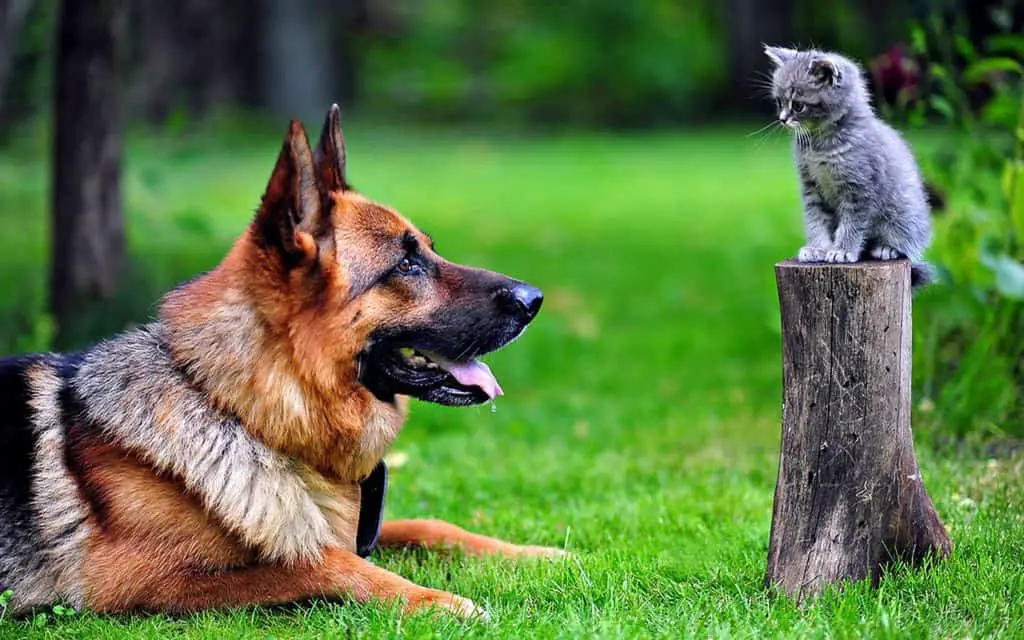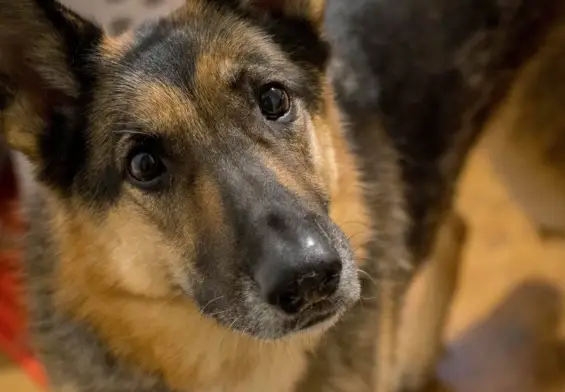Do German Shepherds Get Along With Cats in the Home?
We all probably know about the age-old animosity between cats and dogs. A lot of children’s stories tell tales of how dogs and cats would never get along. A lot of people still picture this animosity as the hate that taxpayers have for paying taxes. It’s a rivalry that has existed since the first cat and dog lived in the same neighborhood. However, this rivalry’s intensity isn’t entirely as strong as we might have been made to believe. If you are considering taking a cat and a German Shepherd as pets under the same roof, this article will help you understand how well the two animals can get along with each other.
Are Cats and German Shepherds Naturally Friends?
Unfortunately, No! Cats can get very petty at times, especially with other animals. On the other hand, a German Shepherd pretty much sees many other smaller animals as prey. Domesticate them all you want, dogs are instinctive predators, and these traits will still reflect in their lifestyle one way or the other. German Shepherds are herd dogs. One of their primary instincts is to chase.
Fluffy creatures like cats could even be so much more fun for German Shepherds to chase around. This kind of behavior is ingrained in their genes. Although they might not really harm the cat, the cat being chased wouldn’t find it funny. Consequently, when a dog is always chasing or hunting down a cat, it’s obvious why the cat wouldn’t be very comfortable with accepting it as a friend. However, it doesn’t mean that the cat-dog relationship is doomed to fail. There are several homes that cats and German Shepherds are living amicably with each other. There are also several homes where both animals are constantly at war. So what can be done to broker peace between these two lifelong enemies?
Below are some factors that determine whether your German Shepherd will get along with your cat and how you can also help them get along.
Personality Of The Cat and The German Shepherd
Natural instincts aside, a German Shepherd’s personality will significantly impact its willingness to accept a feline friend. Dogs are much like humans. While some dogs genuinely like meeting new animals, some are reserved and prefer keeping to themselves (and canine family). Most cats are usually cautious and reserved, and this could be a good thing. However, a cat that doesn’t respect personal boundaries will easily irritate a German Shepherd that is trying to get used to a feline presence. This is usually a recipe for all-out war.
Age of The German Shepherd and The Cat
A puppy and a kitten have greater chances of getting along well with each other than their grown-up counterparts. Even in situations that they don’t get along quite well, it’s relatively easier to help them get along while they are still young. On the other hand, mature dogs and cats are less likely to get along when introduced to each other. It is not an impossibility, but it is just less likely. Several American homes have reported adopting mature cats and dogs that have gotten along incredibly well with each other. However, don’t always expect this result.
Prior Experience (Earlier Socialization)
Notice how kids who barely attend parties or go out to meet other kids seem a little socially awkward? Some of them might even prefer being alone to being in the company of others. Things aren’t much different in the canine and feline world. If your German Shepherd has always stayed indoors and barely met other animals, asking it to get all cozy with a cat might be a big ask. On the other hand, if your dog had met other cats before and socialized comfortably with them when you bring home a feline pet, it should have little to no problem getting along with it. However, there’s also a bad side to prior socialization experience. If your feline or canine pet has had a bad experience with a dog or a cat (respectively), then getting along might be a little rocky. If, for instance, a cat gave your dog some paw scratches during a walk in the park, bringing a cat home might unearth unsettled rivalries.
Training
With animals like dogs, most of the things in its lifestyle all boils down to training. If you’ve previously trained your German Shepherd to be friendly with other animals, adopting a cat in the same home shouldn’t be much of a problem.
While the above-listed factors impact the ease at which your German Shepherd and cat can get along with each other, there are some things you can do to help make it easier. Below are some proven ways to help your German Shepherd get along with your cat.
Use a Controlled Introduction
You can bring home a cat, and it settles in comfortably with your German Shepherd without any tantrums. However, you can also bring home a cat, and they pair end up being at each other’s throats. You can choose to try out which result you’ll get. However, the problem is, once you get the second result, you’ve lost the opportunity of an easily controlled introduction. By controlled introduction, you gradually get the German Shepherd and the cat used to each other without necessarily making them stay together. Using a controlled introduction, you significantly boost the chances of your German Shepherd being unaggressive against your cat. But how do you carry out a controlled introduction?
How to carry out a Controlled Introduction of Cats To A German Shepherd
Before you carry out a controlled introduction, your German Shepherd should have undergone basic training. The prerequisite for controlled introduction is for your dog to understand commands like asking it to sit, move, or remain calm. It should be able to follow basic commands you give it without hesitation. Without this, it could be incredibly hard to carry out a controlled introduction. If your German Shepherd doesn’t have basic training, then you must teach it to them. Luckily, German Shepherds are like the brains of the dog clan; they’re quite intelligent and can learn fast. If you’re sure that your German Shepherd can understand basic commands, then the next thing you need to put in place is a basic shelter for your cat.
Before you bring a new cat into your home, ensure the cat has a place to get comfortable. Put its bedding and toys in place. This will let the cat know it has a personal place to head to should things go haywire with its canine housemate. After you’ve put the cat’s shelter in place, it’s time to start the controlled introduction.
The Introduction
The first thing you need to do to kick-start the controlled introduction process is scent swapping. It is probably the most crucial step in the process. To carry out scent swapping, you’ll need to get two clean clothes, one for your German Shepherd and one for your cat. As the name implies, scent swapping aims to get both animals conversant with each other’s scent. You need to rub each of the clothes on the scent glands of the animals. One cloth rubbed on the dog’s scent glands and the other on the scent gland of the cat. You can find a cat’s scent glands around its chin and cheek and on its forehead. On dogs, you can find the scent glands on their armpits and their sides. Rub the cloth allocated to them on their respective scent glands and place it on the other animal’s environment.
You don’t need to force the animal to scent the cloth. Just place the cloth in a place that they’ll eventually sniff willingly. Once the sniff the cloth, you need to observe how they react to the other animal’s scent. Observe whether your dog acts hostile or inquisitive after it smells the cat’s scent. Also, observe whether the cat acts nervous or uneasy after it smells the dog’s scent. You need to keep updating the scent on the clothes daily. This will ensure both the dog and the cat eventually get used to each other’s scent.
After scent swapping, the next thing is to get the dog and the cat to see each other from a safe distance while you observe their reaction. You can put the cat inside the house and the cat outside in such a way that they can see each other. This safe distance will avert the possibility of aggressive contact between both animals. Keep doing this for a while and reward both animals with treats each time they act nice towards each other.
After some time meeting within safe distances, you can bring the animals inside at the same time but not too close. However, ensure that the dog is on a leash. This will allow your cat to run off should things get hostile. Keep doing this for several days while giving the dog more freedom each day. Whenever you’re very confident that your dog will not get aggressive against your cat, you can release it from the leash and allow them to mingle together.





